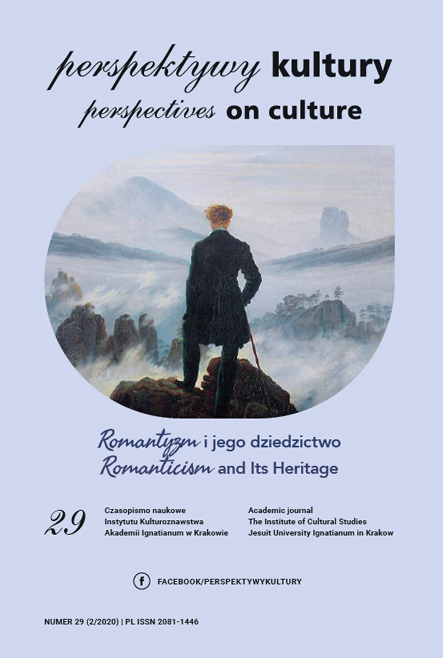Zagubione sensoria: antropologiczne badania nad doświadczeniem sensualnym w kontekście wielokulturowości
Abstrakt
Tematem niniejszego studium jest doświadczenie sensoryczne oraz jego społeczne manifestacje. Wychodząc od klasycznego porządku pięciu zmysłów, przedstawione zostaną alternatywne porządki sensoryczne oraz ich społeczne i kulturowe umocowanie. Językowe obrazy doświadczenia zmysłowego, postulowana synchroniczność procesów sensorycznych oraz koncepcja etnopoetyki stanowią podstawę prezentowanej koncepcji zagubionych sensoriów.
Bibliografia
Agawu, K. (1995). African Rhythm: A Northern Ewe Perspective. Cambridge: Cambridge University Press.
Ahearn, L.M. (2013). Antropologia lingwistyczna. Wprowadzenie. Kraków: Wydawnictwo Uniwersytetu Jagiellońskiego.
Basso, K. (1996). Wisdom Sits in Places: Landscape and Language Among the Western Apache. Albuquerque: University of New Mexico Press.
Bodzioch-Bryła, B., Dorak-Wojakowska, L. & Smołucha D. (2017). Wzrokocentryzm, wizualność, wizualizacja we współczesnej kulturze. Kraków: Wydawnictwo Naukowe Akademii Ignatianum.
Cascio, C.N., O’Donnell, M.B., Simons-Morton, B.G., Bingham, C.R. & Falk, E.B. (2017). Cultural context moderates neural pathways to social influence. Culture and Brain, 5, 50–70.
Cereceda, V. (2007). O pewnych aspektach estetyki ajmarsko-andyjskiej: Od pojęcia piękna do tinku. In: K. Zajda (ed.), Estetyka Indian Ameryki Południowej. Antologia. Kraków: Universitas, 19–31.
Classen, C. (2012). The Deepest Sense A Cultural History of Touch. Urbana– Chicago–Springfield: University of Illinois Press.
Collins, R. (2004). Interaction Ritual Chains. Princeton–Oxford: Princeton University Press.
Crickmay, L. (1988). Transmission of Knowledge through Textiles: Weaving and Learning How to Live. In: H. Stobart & R. Howard (eds.), Knowledge and Learning in the Andes: Ethnographic Perspectives. Liverpool: Liverpool University Press, 40–55.
Darley, A. (2000). Visual Digital Culture Surface Play and Spectacle in New Media Genres. London–New York: Routledge.
DeBernardi J. (1994). Social Aspects of Language Use. In: T. Ingold, Com¬panion Encyclopedia of Anthropology. London–New York: Routledge, 861–890.
Dransart, P. (1988). Coloured Knowledges: Colour Perception and the Dis¬semination of Knowledge in Isluga, Northern Chile. In: H. Stobart & R. Howard (eds.), Knowledge and Learning in the Andes: Ethnographic Per¬spectives. Liverpool: Liverpool University Press, 56–78.
Duranti, A. (1997). Linguistic Anthropology. Cambridge: Cambridge Univer¬sity Press.
Duranti, A. (2015). The Anthropology of Intentions: Language in a World of Others. Cambridge: Cambridge University Press.
Evans, M. & Whittaker, A. (2010). Sensory Awareness and Social Work. Exeter: Learning Matters Ltd.
Friedrich, P. (2006). Maximizing Ethnopoetics: Fine-tuning Anthropolo¬gical Experience. In: Ch. Jourdan & K. Tuite (eds.), Language, Culture, and Society: Key Topics in Linguistic Anthropology. Cambridge: Cambridge University Press, 207–228.
Geurts, K.L. (2002). On Rocks, Walks, and Talks in West Africa: Cultural Categories and an Anthropology of the Senses. Ethos, 30(3), 178–198.
Ingold, T. (ed.). (1994). Companion Encyclopedia of Anthropology. London– New York: Routledge.
Jourdan, Ch. & Tuite, K. (eds.). (2006). Language, Culture, and Society: Key Topics in Linguistic Anthropology. Cambridge: Cambridge University Press.
MacLaury, R.E., Paramei, G.V. & Dedrick, D. (eds.). (2007). Anthropology of Color: Interdisciplinary Multilevel Modelling. Amsterdam–Philadelphia: John Benjamins Publishing Company.
Manghani, S., Piper, A. & Simons, J. (eds.). (2006). Images: A Reader. Lon¬don–Thousand Oaks: Sage Publications Ltd.
Pradier, J.-M. (2012). Ciało widowiskowe. Etnoscenologia sztuk widowisko¬wych. Warszawa: Wydawnictwo Naukowe PWN.
Schechner, R. (2006). Performatyka: Wstęp. Wrocław: Ośrodek Badań Twór¬czości Jerzego Grotowskiego i Poszukiwań Teatralno-Kulturowych.
Tuomela, R. (2013). Social Ontology: Collective Intentionality and Group Agents. Oxford: Oxford University Press.
Waskul, D. & Vannini, P. (2006). Body Embodiment: Symbolic Interaction and the Sociology of the Body. Aldershot–Hampshire, Ashgate Publishing, Ltd.
Wilson, D.S., Timmel, J.J. & Miller, R.R. (2005). Cognitive Cooperation: When the Going Gets Tough, Think as a Group. In: N. Gold (ed.), Teamwork: Multi-Disciplinary Perspectives. Houndmills–Basingstoke– Hampshire–New York: Palgrave–Macmillan, 33–55.
Copyright (c) 2020 Akademia Ignatianum w Krakowie

Utwór dostępny jest na licencji Creative Commons Uznanie autorstwa – Bez utworów zależnych 4.0 Międzynarodowe.
Autor, zgłaszając swój artykuł, wyraża zgodę na korzystanie przez Wydawnictwo Uniwersystet Ignatianum z utworu na następujących polach eksploatacji:
- utrwalania utworu w formie papierowej, a także na nośniku cyfrowym lub magnetycznym;
- zwielokrotnienia utworu dowolną techniką, bez ograniczenia ilości wydań i liczby egzemplarzy;
- rozpowszechniania utworu i jego zwielokrotnionych egzemplarzy na jakimkolwiek nośniku, w tym wprowadzenia do obrotu, sprzedaży, użyczenia, najmu;
- wprowadzenia utworu do pamięci komputera;
- rozpowszechniania utworu w sieciach informatycznych, w tym w sieci Internet;
- publicznego wykonania, wystawienia, wyświetlenia, odtworzenia oraz nadawania i reemitowania, a także publicznego udostępniania utworu w taki sposób, aby każdy mógł mieć do niego dostęp w miejscu i czasie przez siebie wybranym.
Wydawca zobowiązuje się szanować osobiste prawa autorskie do utworu.





